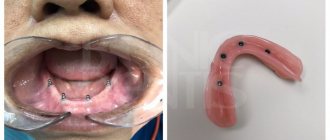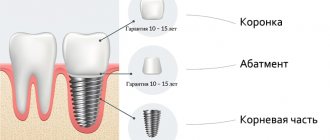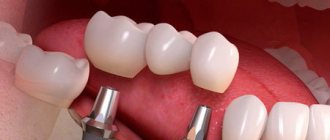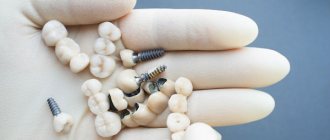Types of temporary dentures
Today, dental medicine offers several types of temporary dentures. What types of structures these will be depends on the clinical situation in the patient’s oral cavity, as well as on the budget. Indeed, for each prosthetic plan there is a whole range of proposals, which is associated with the constant development of technology in this area, and in connection with this - the replenishment of the product line of prosthetic structures.
Types of designs
A removable denture is popularly called a “butterfly” for its similar appearance. Usually this is a temporary denture for one tooth. It is made from a material (usually plastic) that does not cause allergies. There are “petals” made of nylon on the sides, which ensures fixation on adjacent teeth.
Modern temporary dentures for the front teeth are not much different in appearance from natural teeth. They completely repeat the anatomical shape and have the color of the enamel of the dentition.
Read Loose teeth - treatment and prevention
Types of temporary fixed prostheses
A temporary denture for one tooth may not be removed after installation. In such a case, we are talking about permanent design structures, which include:
- crowns;
- bridges.
They are put on the ground teeth, but only for a while, while more expensive crowns are in the process of being manufactured. They can also be placed on implants during the period of prosthetics and engraftment.
Non-permanent dentures during the implantation period
Permanent crowns put strong pressure on the implanted implants during the chewing process. To make the recovery process faster, it is advisable to install temporary prostheses (crown - cap covering the metal part of the implant) made of lightweight material during the implantation period. As soon as the artificial root has taken root, for example, a prosthesis made of metal ceramics, etc. is installed.
Temporary dentures for front teeth
prosthetic design butterfly for 3 teeth
A temporary denture for the lower or upper jaw is simply necessary if the front teeth have fallen out. An aesthetic defect makes a person feel embarrassed, behave unnaturally, constrained, talk less, and smile less. Long-term gapping leads to displacement of the dentition, which further complicates the implantation process.
Side effects with temporary prosthetics
Despite the fact that such structures are lightweight options and are installed for a short period of time, their constant presence in the oral cavity can also cause the development of negative consequences. Among them:
- irritation of soft tissues around the prosthesis;
- inflammatory diseases of the mucous membrane in the mouth;
- allergic reaction to painkillers or material;
- structural damage;
- the appearance of a lisp;
- disruption of local blood supply.
The dentists of our clinic will help you quickly and efficiently deal with problems if temporary dentures have been installed incorrectly. For this purpose, modern diagnostic equipment and materials are available.
For the convenience of patients, the clinic is open every day from 9.00 to 21.00, but a request for a visit can be left online. We have discounts, promotions and installment plans.
Come to us for high-quality temporary prosthetics and smile comfortably!
Why are temporary dentures needed?
Dentures such as temporary ones are installed in various situations. First of all, patients are attracted by their cost and purpose.
Useful features of temporary dentures
There are several functions of temporary structures:
- aesthetic appeal;
- replenishment of lost teeth;
- reduction of dentition displacement;
- protection of the ground tooth from food and saliva;
- the patient’s adaptation to the prosthesis (later to a permanent one), which is initially perceived as a foreign body.
In what cases are they installed?
A structure is installed to implement the above functions.
Temporary dentures and crowns for dental implantation
During the engraftment of a permanent implant or the manufacture of a prosthesis, the following orthopedic structures can be used:
Immediate dental prosthesis “Butterfly”
- Fixed temporary crown on a permanent implant, removed from the bite . Used for single restorations with sufficient bone volume. The installation conditions are to carry out simultaneous implantation immediately after extraction. It is made of lightweight plastic, restores aesthetics, but does not perform a full chewing function. The crown is made smaller than natural teeth to be removed from the bite in order to limit the load on the implant until it is completely implanted.
- metal-plastic prot . Indicated for a one-stage protocol with immediate loading against the background of complete edentia. It is a crown on an artificial gum and acts as a stabilizer. Can be used for complete chewing of food.
- Removable dental guard . It looks like a transparent plastic cap with an artificial crown in the empty space. It is fixed on the entire dentition and does not overload the implant.
- Removable immediate prosthesis - crowns on a plastic base. When making prosthetics, all teeth rest on the gums; in other cases, on the patient’s gums and natural teeth (additionally, hooks are used). Relevant for multiple restorations.
- Fixed adhesive bridge prosthesis. Installed to replace 1-2 units. Using two petals, they are fixed on the inside of living teeth. Does not withstand significant chewing load.
Hygienic care rules
In order for the structure to last longer, it is necessary to properly care for it.
- The denture should be cleaned of food debris that can cause inflammation of the oral mucosa and become a source of unpleasant odor.
- It is recommended to choose a brush of medium hardness.
- After eating, it is advisable to rinse the mouth with decoctions or ready-made pharmaceutical compositions (balms).
- The prosthesis must be treated in a special medicinal solution, which can be purchased at the pharmacy chain.
- Hard or sticky foods should be avoided.
- Dental floss must be used very carefully so that the structure does not become deformed.
Read Learning how to properly store removable dentures
General information: how long does it take to make and what does a temporary prosthesis look like?
Prosthetics is a long, expensive process. Lack of time and financial resources should not be the reason for an unattractive smile or poor chewing of solid food. With the help of temporary dentures, the functions of lost teeth can be replaced for a short period of time.
Depending on the type of structure, the time required for its production varies, but it is still required much less than for the production of permanent dentures. On average, a structure for temporary use is made in a few hours.
Temporary dentures photo
You can see the appearance of the dentures in detail in the photo. In addition, with its help, it is possible to familiarize yourself with structures that have changed during operation, for example, blackened or cracked, deformed.
Temporary plastic crowns for implants
plastic temporary dentures
removable temporary prosthesis - butterfly
silicone design for one tooth
Temporary denture price
Temporary dentures differ in price from the cost of permanent dentures. This allows a person to get rid of the disadvantage of missing teeth. How much does a prosthesis cost? The answer largely depends on the pricing policy of the clinic the client visits. On average, plastic crowns cost 2,000 rubles, “butterflies” - 15,000 rubles.
What is the difference between temporary dentures and permanent ones?
In dental practice, temporary dentures are used as an intermediate link between implantation and the installation of permanent crowns. The main difference between a temporary prosthesis and a permanent one is its weight.
The metal base of the temporary crown is coated with acrylic, a synthetic material made from resins. Permanent dentures also have a metal base, but are covered not with plastic, but with durable zirconium ceramics. Thus, the difference in the weight of permanent and temporary dentures is due to the difference in the density of the acrylic and ceramic shells. The specific gravity of zirconium dioxide ceramics is approximately 5.7 g/cm3, and acrylic is 1.19 g/cm3.
The lightweight plastic shell does not have the strength and durability of zirconium ceramics, but is characterized by good resistance to impacts, moisture and microorganisms, light resistance, resistance to corrosion and exposure to UV rays. Such characteristics allow acrylic to be the optimal material for the manufacture of surface dental structures, however, low mechanical strength causes a short service life: temporary dentures are installed for no more than 2–3 years.
In turn, durable zirconium crowns are a heavier but durable material that allows the crown to serve for at least 20 years. The use of CAD/CAM systems in dentistry makes it possible to accurately and quickly produce permanent dentures.
What are the advantages of such designs
An important advantage of temporary dentures is their cost. Compared to permanent dentures, it is several times smaller. Huge advantages also include: the ability to remove and reinstall them as needed, and to compensate for lost functions (functional and aesthetic) with their help.
Video - temporary solution immediate prosthesis butterfly
The butterfly prosthesis is one of the most expensive temporary structures. It is used if one tooth has been lost. With the help of “petals” it is attached to neighboring teeth. The service life of the prosthesis depends on careful treatment. In the video instructions you can familiarize yourself in detail with the design and handling rules of the product.
What can you do to avoid walking with glands in your mouth: temporary dentures save the situation
Temporary dentures on implants can restore the aesthetics of a smile and rid the patient of complexes about his appearance. As for the chewing function, it all depends on the chosen treatment option, on the condition of the bone tissue before implantation, on the models of artificial roots. For example, with one-stage protocols, the patient receives a fully functional prosthesis (by the way, it is relatively temporary, that is, it can be worn for up to 3-5 years) within a few days after fixing the implants - this way, you can immediately start chewing without fear that structures will fall out or shift under load.
How temporary dentures are made
The production of temporary prostheses includes several stages:
- preparation of casts;
- preparation of prostheses and their subsequent fixation.
Temporary crowns are created in a few hours. Rarely do they take days to make. The materials (plastic and composite) are chosen to be relatively strong and reliable so that the crowns last the first time and there are no chips, cracks, or darkening . Not only crowns, but also artificial gums are made from plastic. The material, as a rule, does not irritate the oral mucosa. The warranty period is several months.
The process of addiction
Experts distinguish several stages of adaptation to prostheses.
- The location stage is the shortest in time. The patient actively fixes his attention on the structure, as if on a foreign body. A lot of saliva forms in the mouth, the pronunciation of words changes, the chewing load decreases, and the urge to vomit is possible.
- During the second stage (duration up to 7 days), the manifestation of undesirable reactions decreases, that is: salivation (salivation) decreases, words are pronounced more clearly, food is chewed better.
- The third period lasts a month. During this time, a person gets used to the prosthesis and can no longer do without it. The muscular and ligamentous apparatus adapts to the chewing load.
The adaptation process is different for everyone. It is important to endure unpleasant symptoms, after which the quality of life will change for the better.
Adaptation to prostheses installed using All on 4 technology
Successful completion of the period of adaptation to prostheses installed using the ALL-ON-4 technology is a necessary condition for obtaining long-term treatment results.
Adaptation (lat. adapto - I adapt) is the process of adapting the body or its individual organs to changing environmental conditions. An adaptive prosthesis is made from dental materials intended for permanent wear. The speed of adaptation varies from person to person, but since the ALL-ON-4 technology ensures that the prosthesis is always in the mouth, adaptation occurs very quickly. From the moment the prosthesis is installed, the adaptation period begins. By adaptation we mean not only simple addiction, when a person forgets that he has a prosthesis in his mouth (we repeat, this happens quickly), but also the whole complex of changes in the body, bones, muscles, and the central nervous system (central nervous system). During the adaptation period (6 months), the doctor, following such changes, modifies the adaptive prosthesis. The prosthesis is designed in such a way that if the load on it is higher than permissible, it can break, which protects the implants during the healing period.
Objectives of an adaptive prosthesis
- Aesthetic and functional rehabilitation during the period of implant integration and correction
- Development and correction of the boundaries of the prosthesis relative to the gums
- Formation of gum relief
- Development of personal hygiene and prosthesis care skills
- Matching the size and shape of teeth for a permanent denture
- Practicing occlusion and bite height, etc.
The following changes occur:
- the appearance, and later disappearance, of postoperative edema;
- the jaw bone is remodeled in the areas of extracted teeth;
- implants are integrated;
- chewing reflexes change, sending information to the central nervous system, etc.;
- antagonist teeth are changed and evaluated.
Schedule appointments with your doctor
The schedule of meetings with an orthopedic doctor can be individual and depends on the implant installation technology, but, as a rule, the following stages go through:
- Day 1 (90′): the doctor installs the prosthesis and monitors the distribution of the load when the teeth are closed.
- Days 10-14 (40′): removal of sutures and control of the prosthesis. Training in hygiene skills with this prosthesis.
- Day 30-40 (60′): removal of the prosthesis in order to fill the gaps and undercuts formed due to the disappearance of swelling and the beginning of remodeling. Control of fixation of multi-units. This period is the most critical for implants and Al-V alloy, since the mechanical fixation of the implants is reduced, and the bone has not yet grown.
- 2nd month (30′): control visit to detect hidden cracks in the prosthesis, as well as assess the quality and quantity of attached gum in the area where the implants emerge. If necessary, the issue of correction of the soft tissues of the gums or deepening of the vestibule is discussed and a day for correction is appointed (the cost of additional surgical procedures is not included in the initial plan).
- 3rd month (15′): follow-up examination.
- 6th month (30′): control x-ray, correction of the prosthesis (if required), polishing the prosthesis, drawing up an epicrisis, issuing recommendations for instructions, getting to know other types of prostheses made from other materials and using other technologies, assessing their advantages.
Using an adaptive prosthesis for more than the period recommended by a doctor can lead to the following consequences:
- Breakage of the prosthesis, since plastic is not a very durable material and is subject to aging.
- Loss of implants due to a hidden crack or breakage of the prosthesis, which will inevitably lead to overload of one of the implants. Breakage of the prosthesis is absolutely painless and the patient may not notice it at an early stage, but will only discover it when the implant becomes loose.
- The possibility of allergic reactions to plastic at the point of contact with the gums.
- Unsatisfactory hygiene, because it is not always possible to tightly install the adaptive prosthesis to the gum (see point 3).
- Incomplete restoration of chewing function, since on an adaptive non-reinforced prosthesis it is impossible to make releases beyond the distant implants without increasing the risk of prosthesis breakage, because the heaviest chewing load on the teeth occurs there.
How to care
Caring for structures involves timely treatment of them with special solutions. Temporary dentures are not designed for long-term use. So that the prosthesis does not darken , chips or cracks do not form on it, or there is no displacement in the plane, it makes sense to take a careful attitude, including full care. If the dentures are not removable, then it is recommended to rinse the mouth with balms. With their help, you can remove food debris from the interdental spaces, reduce inflammation, etc.
Fixed temporary types
The simplest non-removable temporary dental prosthesis is a classic crown, but made not from reliable and expensive materials such as ceramics or metal alloys, but from plastic. Plastic is not used in permanent prosthetics, as it quickly wears off and darkens, and can also accumulate microbial flora due to its porous surface. But as a temporary option, it is preferable to removable structures, because it is cheap, and is fixed better, while having a more natural appearance. The low strength of the plastic determines the thickness of the crown - at least one millimeter, and for installation the dentist can remove the cervical dental tissues with or without a ledge.
Fixed temporary prosthesis
Temporary dentures of this type are made by two methods, after taking preliminary impressions from the dentition: modeling with wax or directly from plastic.
The first method involves a series of sequential actions:
- the dental neck is engraved on plaster and modeled with colorless wax (with allowance for future grinding of the finished crown);
- a tooth is cut out of the model and cast vertically in a ditch (at an angle if the crown is two-color);
- the wax is melted by immersion in boiling water, then its remains are cleaned from the cuvette with boiling water;
- knead the plastic of the desired shades and use a spatula to transfer it to the cuvette;
- the cuvette halves are secured in a clamp and wait for the plastic to polymerize;
- The almost finished prosthesis is removed, cleaned of plaster, ground and polished.
To use the second method, the mixed plastic is applied to the dental stump, where it hardens under pressure in an express polymerizer. After grinding and polishing, this temporary denture is ready to be installed in the mouth using dental cement and, if necessary, a reinforcing post.
Additional Information. If the entire tooth, including the roots, is missing, the crown should be attached to a bridge structure, which will be secured to the prepared abutment teeth.
Temporary dentures are indistinguishable from real teeth
To avoid the need to grind down teeth to install a bridge, you can resort to an adhesive fixation method. Instead of preparing the entire surface of the tooth, it is enough to cut out small ledges on it, into which inlays will be embedded in cement - supports for the fiberglass tape. Using this tape of filling material, the dentist will form a hinged crown directly in your mouth, which takes no more than two hours.
The price for such a bridge will be lower than for a classic one, and healthy teeth will undergo less processing. But temporary dentures on tape cannot last long, and their strength remains low.
Advantages of temporary prosthetics
One of the main advantages of temporary prosthetics is the cost of the dentures . The price for them and for the services provided is several times less than for permanent dentures. With the help of temporary structures, you can smile beautifully and speak confidently, since they mask a defect in the dentition. During their use, a person begins to get used to them and does not perceive them as a foreign body. This circumstance has a favorable effect on getting used to permanent dentures and their further use.
Removable temporary types
One or two missing teeth are easily replaced with an immediate denture, whose name refers to immediacy and urgency. This device, called a “butterfly” for its appearance, is fixed during one visit to the dentist and does not require preliminary tooth preparation. Fixation is carried out using clippers - hook-shaped processes that cling to the crowns of adjacent teeth.
Mouthguard with removable temporary prostheses
There are three materials available to choose from:
- acrylic;
- polyurethane;
- nylon.
The first type is the most budget-friendly, the third is the most expensive, but at the same time elastic and comfortable to wear. Temporary dentures made of acrylic have the advantage of greater rigidity, which increases the service life of the product, which in any case does not exceed six months.
Note! Butterfly dentures are well suited for use in childhood and adolescence: the jaws are not yet fully formed, so a conservative type of treatment is less preferable.
If a significant number of frontal teeth are lost, it is possible to use full-fledged acrylic or nylon dentures. Such designs are also used as a permanent option, but from the point of view of temporary wearing there is a disadvantage: for reliable fixation, it is necessary to grind the supporting teeth and install crowns on them. Nylon is more flexible and comfortable, which reduces the adaptation period, and its disadvantages relative to acrylic will not have time to appear if the use is limited in time. Acrylic is noticeably cheaper, but the size of its base adjacent to the palate will negatively affect the process of chewing and articulation.
Action in case of prosthesis loss
Temporary crowns are not reliable structures. They can jump out of their place. In this case, the only correct action would be to contact a specialist. With its help, the crown will be cemented. If it is not possible to go to the clinic in the next few days, then you can resort to a little trick: fill the crown with toothpaste and fix it in its original place. You can use this technique for several days. Before going to bed, the crown should be removed to avoid accidental swallowing and harm to the teeth.










